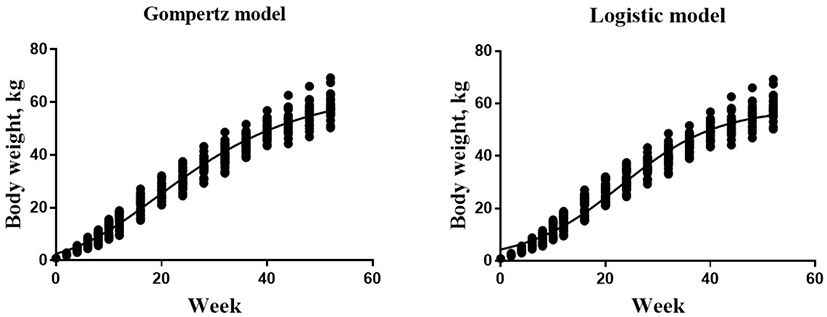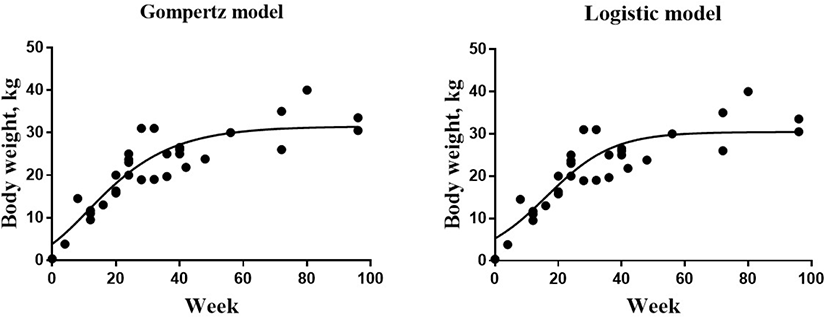INTRODUCTION
Swine are widely used as models for human due to the similarities in anatomy of the digestive systems and physiologic characteristics [1]. Mini-pigs are a useful laboratory animal for safety evaluation of pharmaceuticals, organ transplantation studies and nutritional studies [2,3]. In contrast to commercial pigs selected for fast growth, mini-pigs grow relatively slowly and their mature body weight (BW) is less than commercial pigs. Due to the relatively small BW, mini-pigs have many advantages in general managements and animal handlings. Mini-pigs can be used in swine nutrition studies with limited quantity of test ingredients and in experiments requiring surgeries such as ileal T-cannula insertion for ileal digestibility assessment [4–6].
Information on growth potential of experimental animals is important in planning and designing animal experiments as well as in optimizing animal production efficiencies. Many studies for modeling growth curves of various animals have been conducted [7–9]. However, information on growth curves of mini-pig breeds is very limited. Therefore, the present study aimed to develop growth curve models for novel mini-pig breeds.
MATERIALS AND METHODS
Two mini-pig breeds used in the present work were an M-Pig® breed originated from Korean Jeju Island’s native pigs (Cronex, Hwaseong, Korea) and Micro-pig® (Medi Kinetics, Pyeongtaek, Korea). The M-Pig® is a selected Jeju Island’s native pig breed with slow BW growth rate and the Micro-pig® is a crossbreed developed by breeding white gilts selected from cross breeds (Korean native pig, Yucatan mini-pig, Vietnamese pot-bellied pig, and Pygmy pig) with Meishan boars.
For the growth analysis, BW data for M-Pig® (Cronex) were obtained from Cronex and data for Micro-pig® (Micro-pig®; Medi Kinetics) were from 20 published experiments. A total 680 BW data for the M-Pig® ranging from 0.8 to 63.2 kg BW for 40 animals were collected from birth to 52 weeks of age and a total of 36 BW and age data (mean values representing 128 pigs) for the Micro-pig® ranging from 0.35 to 33.5 kg BW were obtained from birth to 96 weeks.
The growth curves of two different mini-pig breeds by nonlinear regression were generated using the NLIN procedure of SAS (SAS Institute, Cary, NC, USA). The growth models employed in this work were Gompertz and Logistic models with 3 parameters in the equation [10,11]:
where Wt is the BW at t week; A is the mature weight; b is the growth ratio; k is the maturing rate; and e is the natural logarithm. The models were compared using corrected R2 which is calculated by MEANS procedure of SAS. Based on the estimated growth parameters, the characteristics of growth curve were induced, that are age at point of inflection, gain at inflection and weight at inflection. In the Gompertz model, the age at point of inflection (ti), weight at inflection (Wti) and gain at inflection (∂Wt/∂t) are [12]:
ti = (Logeb) / k, Wti = A / e and dyi / dti = kbwtie–kt, respectively.
In the Logistic model,
ti = (Logeb) / k, Wti = A / 2 and dyi / dti = Abkekti / (ekti + b)2, respectively.
The inflection point is the week at which the slope of the growth curve becomes maximum. In other words, the second derivative of the time of models used for growth curve estimation was calculated to be zero.
RESULTS AND DISCUSSION
The Gompertz model fitted better than the Logistic model in both mini-pig breeds based on determination coefficients (Table 1). This observation implies that a Logistic model tends to estimate upward and downward for early and mature weight, respectively [13]. Except for the maturing rate, the mature BW and growth rate of M-pig® were higher than in Micro-pig®. This difference can be partly explained by different breeding methods. The M-pig® breed was developed by selecting Korean Jeju Island’s native pigs with slow BW growth rate, whereas the Micro-pig® was developed by breeding white gilts selected from cross breeds (Korean native pig, Yucatan mini-pig, Vietnamese pot-bellied pig, and Pygmy pig) with Meishan boars. All characteristics at inflection point of M-pig® were greater than those of Micro-pig® (Table 2).
A, mature body weight; b, growth ration; k, maturing rate.
Graphical comparisons of the growth models for M-pig® and Micro-pig® are illustrated in Figs. 1 and 2, respectively. Apparently, mature BW of both mini-pig breeds are less than that of conventional Korean native breeds and crossbreds. Mature BW of the crossbred between Korean native boars and Landrace sows has been reported to be 179.7 kg [14]. In addition, the mature BW of Korean Jeju Isaland’s native pigs and a crossbred between Korean natvie sows and Duroc are 154.3 and 170.8, respectively [15]. Considering the small or optimal size, these mini-pig breeds are useful for pharmaceutical evaluation and organ transplantation research. The mini-pig breeds can also be used for swine nutrition experiments when the quantity of a test feedstuff is not sufficient for experimentation using commercial pigs or the large size of commercial pigs is a limiting factor. An accurate determination of amino acid digestibility of swine diets requires surgical insertion of T-cannula into the terminal ileum [5,6,16], which has been used in many experiments employing commercial pigs [4,6,15–18]. However, a T-cannula equipped in commercial growing pigs does not last more than three to four months. The mini-pigs breeds are useful for overcoming the limitation of commercial pigs. The information provided in the present work can be used for designing and planning swine nutrition research.


In conclusion, modeling of growth curves for a novel mini-pig breed with differennt growth models is a useful tool for designing experiments employing the mini-pig breed as well as for general management of these animals. Additionally, the novel mini-pig breed can be used in experiments for a longer period compared with commercial pigs.






